traction control Seat Altea XL 2010 Owner's Manual
[x] Cancel search | Manufacturer: SEAT, Model Year: 2010, Model line: Altea XL, Model: Seat Altea XL 2010Pages: 312, PDF Size: 8.41 MB
Page 5 of 312
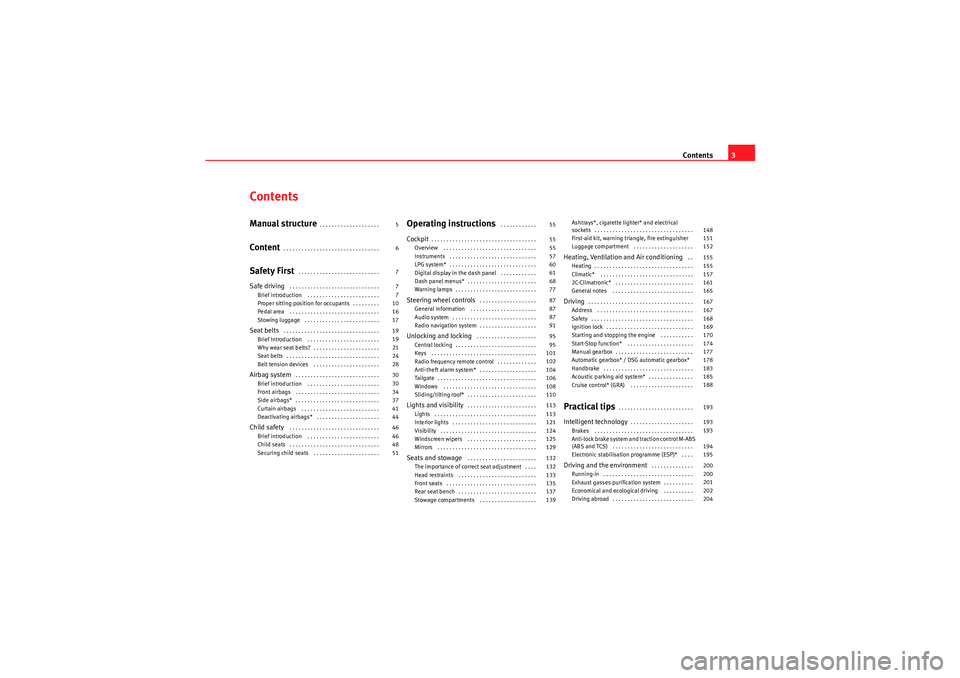
Contents3
ContentsManual structure
. . . . . . . . . . . . . . . . . . . .
Content
. . . . . . . . . . . . . . . . . . . . . . . . . . . . . . . .
Safety First
. . . . . . . . . . . . . . . . . . . . . . . . . . .
Safe driving
. . . . . . . . . . . . . . . . . . . . . . . . . . . . . .
Brief introduction . . . . . . . . . . . . . . . . . . . . . . . .
Proper sitting position for occupants . . . . . . . . .
Pedal area . . . . . . . . . . . . . . . . . . . . . . . . . . . . . .
Stowing luggage . . . . . . . . . . . . . . . . . . . . . . . . .
Seat belts
. . . . . . . . . . . . . . . . . . . . . . . . . . . . . . . .
Brief Introduction . . . . . . . . . . . . . . . . . . . . . . . .
Why wear seat belts? . . . . . . . . . . . . . . . . . . . . . .
Seat belts . . . . . . . . . . . . . . . . . . . . . . . . . . . . . . .
Belt tension devices . . . . . . . . . . . . . . . . . . . . . .
Airbag system
. . . . . . . . . . . . . . . . . . . . . . . . . . . .
Brief introduction . . . . . . . . . . . . . . . . . . . . . . . .
Front airbags . . . . . . . . . . . . . . . . . . . . . . . . . . . .
Side airbags* . . . . . . . . . . . . . . . . . . . . . . . . . . . .
Curtain airbags . . . . . . . . . . . . . . . . . . . . . . . . . .
Deactivating airbags* . . . . . . . . . . . . . . . . . . . . .
Child safety
. . . . . . . . . . . . . . . . . . . . . . . . . . . . . .
Brief introduction . . . . . . . . . . . . . . . . . . . . . . . .
Child seats . . . . . . . . . . . . . . . . . . . . . . . . . . . . . .
Securing child seats . . . . . . . . . . . . . . . . . . . . . .
Operating instructions
. . . . . . . . . . . .
Cockpit
. . . . . . . . . . . . . . . . . . . . . . . . . . . . . . . . . . .
Overview . . . . . . . . . . . . . . . . . . . . . . . . . . . . . . .
Instruments . . . . . . . . . . . . . . . . . . . . . . . . . . . . .
LPG system* . . . . . . . . . . . . . . . . . . . . . . . . . . . . .
Digital display in the dash panel . . . . . . . . . . . .
Dash panel menus* . . . . . . . . . . . . . . . . . . . . . . .
Warning lamps . . . . . . . . . . . . . . . . . . . . . . . . . . .
Steering wheel controls
. . . . . . . . . . . . . . . . . . .
General information . . . . . . . . . . . . . . . . . . . . . .
Audio system . . . . . . . . . . . . . . . . . . . . . . . . . . . .
Radio navigation system . . . . . . . . . . . . . . . . . . .
Unlocking and locking
. . . . . . . . . . . . . . . . . . . .
Central locking . . . . . . . . . . . . . . . . . . . . . . . . . . .
Keys . . . . . . . . . . . . . . . . . . . . . . . . . . . . . . . . . . .
Radio frequency remote control . . . . . . . . . . . . .
Anti-theft alarm system* . . . . . . . . . . . . . . . . . . .
Tailgate . . . . . . . . . . . . . . . . . . . . . . . . . . . . . . . . .
Windows . . . . . . . . . . . . . . . . . . . . . . . . . . . . . . .
Sliding/tilting roof* . . . . . . . . . . . . . . . . . . . . . . .
Lights and visibility
. . . . . . . . . . . . . . . . . . . . . . .
Lights . . . . . . . . . . . . . . . . . . . . . . . . . . . . . . . . . .
Interior lights . . . . . . . . . . . . . . . . . . . . . . . . . . . .
Visibility . . . . . . . . . . . . . . . . . . . . . . . . . . . . . . . .
Windscreen wipers . . . . . . . . . . . . . . . . . . . . . . .
Mirrors . . . . . . . . . . . . . . . . . . . . . . . . . . . . . . . . .
Seats and stowage
. . . . . . . . . . . . . . . . . . . . . . .
The importance of correct seat adjustment . . . .
Head restraints . . . . . . . . . . . . . . . . . . . . . . . . . .
Front seats . . . . . . . . . . . . . . . . . . . . . . . . . . . . . .
Rear seat bench . . . . . . . . . . . . . . . . . . . . . . . . . .
Stowage compartments . . . . . . . . . . . . . . . . . . . Ashtrays*, cigarette lighter* and electrical
sockets . . . . . . . . . . . . . . . . . . . . . . . . . . . . . . . . .
First-aid kit, warning triangle, fire extinguisher
Luggage compartment . . . . . . . . . . . . . . . . . . . .
Heating, Ventilation and Air conditioning
. .
Heating . . . . . . . . . . . . . . . . . . . . . . . . . . . . . . . . .
Climatic* . . . . . . . . . . . . . . . . . . . . . . . . . . . . . . .
2C-Climatronic* . . . . . . . . . . . . . . . . . . . . . . . . . .
General notes . . . . . . . . . . . . . . . . . . . . . . . . . . .
Driving
. . . . . . . . . . . . . . . . . . . . . . . . . . . . . . . . . . .
Address . . . . . . . . . . . . . . . . . . . . . . . . . . . . . . . .
Safety . . . . . . . . . . . . . . . . . . . . . . . . . . . . . . . . . .
Ignition lock . . . . . . . . . . . . . . . . . . . . . . . . . . . . .
Starting and stopping the engine . . . . . . . . . . .
Start-Stop function* . . . . . . . . . . . . . . . . . . . . . .
Manual gearbox . . . . . . . . . . . . . . . . . . . . . . . . . .
Automatic gearbox* / DSG automatic gearbox*
Handbrake . . . . . . . . . . . . . . . . . . . . . . . . . . . . . .
Acoustic parking aid system* . . . . . . . . . . . . . . .
Cruise control* (GRA) . . . . . . . . . . . . . . . . . . . . .
Practical tips
. . . . . . . . . . . . . . . . . . . . . . . . .
Intelligent technology
. . . . . . . . . . . . . . . . . . . . .
Brakes . . . . . . . . . . . . . . . . . . . . . . . . . . . . . . . . .
Anti-lock brake system and traction control M-ABS
(ABS and TCS) . . . . . . . . . . . . . . . . . . . . . . . . . . .
Electronic stabilisation programme (ESP)* . . . .
Driving and the environment
. . . . . . . . . . . . . .
Running-in . . . . . . . . . . . . . . . . . . . . . . . . . . . . . .
Exhaust gasses purification system . . . . . . . . . .
Economical and ecological driving . . . . . . . . . .
Driving abroad . . . . . . . . . . . . . . . . . . . . . . . . . . .
5
6
7
7
7
10
16
17
19
19
21
24
28
30
30
34
37
41
44
46
46
48
51 55
55
55
57
60
61
68
77
87
87
87
91
95
95
101
102
104
106
108
110
113
113
121
124
125
129
132
132
133
135
137
139 148
151
152
155
155
157
161
165
167
167
168
169
170
174
177
178
183
185
188
193
193
193
194
195
200
200
201
202
204
AlteaXL_EN.book Seite 3 Dienstag, 1. September 2009 10:37 10
Page 88 of 312
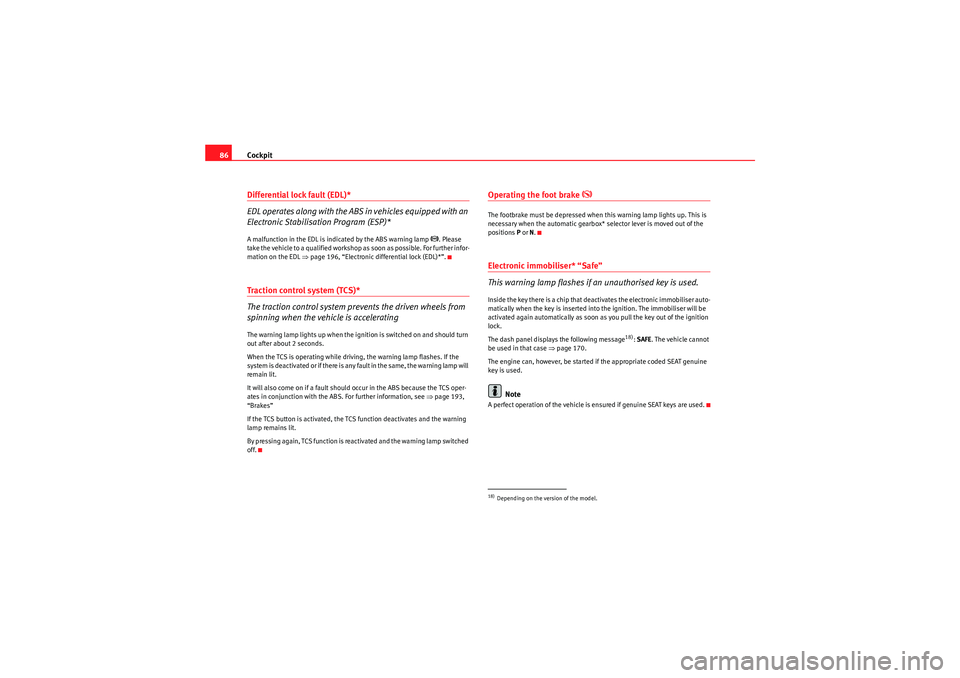
Cockpit
86Differential lock fault (EDL)*
EDL operates along with the ABS in vehicles equipped with an
Electronic Stabilisation Program (ESP)*A malfunction in the EDL is indicated by the ABS warning lamp
. Please
take the vehicle to a qualified workshop as soon as possible. For further infor-
mation on the EDL ⇒page 196, “Electronic differential lock (EDL)*”.
Traction control system (TCS)*
The traction control system prevents the driven wheels from
spinning when the vehicle is acceleratingThe warning lamp lights up when the ignition is switched on and should turn
out after about 2 seconds.
When the TCS is operating while driving, the warning lamp flashes. If the
system is deactivated or if there is any fault in the same, the warning lamp will
remain lit.
It will also come on if a fault should occur in the ABS because the TCS oper-
ates in conjunction with the ABS. For further information, see ⇒page 193,
“Brakes”
If the TCS button is activated, the TCS function deactivates and the warning
lamp remains lit.
By pressing again, TCS function is reactivated and the warning lamp switched
off.
Operating the foot brake
The footbrake must be depressed when this warning lamp lights up. This is
necessary when the automatic gearbox* selector lever is moved out of the
positions P or N.Electronic immobiliser* “Safe”
This warning lamp flashes if an unauthorised key is used.Inside the key there is a chip that deactivates the electronic immobiliser auto-
matically when the key is inserted into the ignition. The immobiliser will be
activated again automatically as soon as you pull the key out of the ignition
lock.
The dash panel displays the following message
18): SAFE . The vehicle cannot
be used in that case ⇒page 170.
The engine can, however, be started if the appropriate coded SEAT genuine
key is used.
Note
A perfect operation of the vehicle is ensured if genuine SEAT keys are used.18)Depending on the version of the model.
AlteaXL_EN.book Seite 86 Dienstag, 1. September 2009 10:37 10
Page 170 of 312

Driving
168•Adjust the driver seat or steering wheel so that there is a distance of at
least 25 cm between the steering wheel and your chest ⇒page 167,
fig. 137 . If you fail to observe the minimum distance, the airbag will not
protect you. Risk of fatal injury.•If your physical constitution does not allow you to maintain the
minimum distance of 25 cm, contact an Authorised Service Centre. The
Authorised Service Centre will help you to decide if special specific modifi-
cations are necessary.•If you adjust the steering wheel so that it points towards your face, the
driver airbag will not protect you properly in the event of an accident. Make
sure that the steering wheel points towards your chest.•When driving, always hold the steering wheel with both hands on the
outside of the ring at the 9 o'clock and 3 o'clock positions. Never hold the
steering wheel at the 12 o'clock position, or in any other manner (e.g. in
the centre of the steering wheel, or on the inside of the rim). In such cases,
you could receive severe injuries to the arms, hands and head.
SafetyElectronic stabilisation programme (ESP)*
ESP helps make driving safer in certain situations.The Electronic Stabilisation Program (ESP) contains the electronic differential
lock (EDL) and the traction control system (TCS). The ESP function works
together with the ABS. Both warning lamps will light up if the ESP or ABS
systems are faulty.
The ESP is started automatically when the engine is started.
The ESP is always active, and cannot be switched off. With the ESP switch it is
only possible to switch TCS off.
The TCS can be deactivated when in cases where wheel sliding is desirable.
For example:•When driving with snow chains,
WARNING (continued)
Fig. 138 Detail of the
centre console: ESP
button
AlteaXL_EN.book Seite 168 Dienstag, 1. September 2009 10:37 10
Page 184 of 312
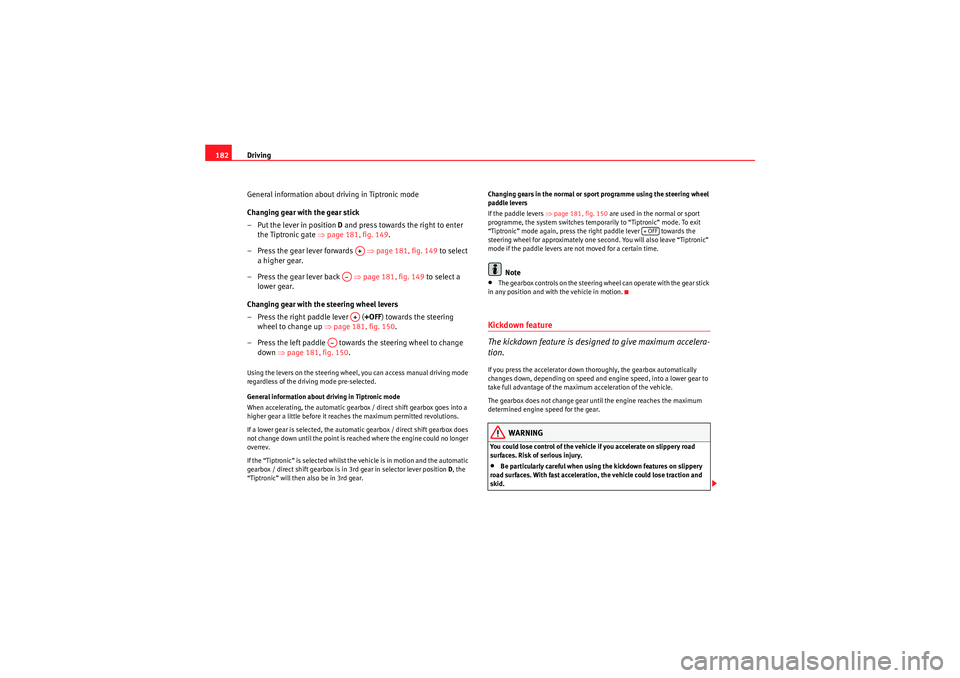
Driving
182
General information about driving in Tiptronic mode
Changing gear with the gear stick
– Put the lever in position D and press towards the right to enter
the Tiptronic gate ⇒page 181, fig. 149 .
– Press the gear lever forwards ⇒page 181, fig. 149 to select
a higher gear.
–Press the gear lever back ⇒ page 181, fig. 149 to select a
lower gear.
Changing gear with the steering wheel levers
– Press the right paddle lever ( +OFF) towards the steering
wheel to change up ⇒page 181, fig. 150 .
– Press the left paddle towards the steering wheel to change down ⇒page 181, fig. 150 .Using the levers on the steering wheel, you can access manual driving mode
regardless of the driving mode pre-selected.
General information about driving in Tiptronic mode
When accelerating, the automatic gearbox / direct shift gearbox goes into a
higher gear a little before it reaches the maximum permitted revolutions.
If a lower gear is selected, the automatic gearbox / direct shift gearbox does
not change down until the point is reached where the engine could no longer
overrev.
If the “Tiptronic” is selected whilst the vehicle is in motion and the automatic
gearbox / direct shift gearbox is in 3rd gear in selector lever position D, the
“Tiptronic” will then also be in 3rd gear. Changing gears in the normal or sport programme using the steering wheel
paddle levers
If the paddle levers ⇒
page 181, fig. 150 are used in the normal or sport
programme, the system switches temporarily to “Tiptronic” mode. To exit
“Tiptronic” mode again, press the right paddle lever towards the
steering wheel for approximately one second. You will also leave “Tiptronic”
mode if the paddle levers are not moved for a certain time.
Note
•The gearbox controls on the steering wheel can operate with the gear stick
in any position and with the vehicle in motion.Kickdown feature
The kickdown feature is designed to give maximum accelera-
tion.If you press the accelerator down thoroughly, the gearbox automatically
changes down, depending on speed and engine speed, into a lower gear to
take full advantage of the maximum acceleration of the vehicle.
The gearbox does not change gear until the engine reaches the maximum
determined engine speed for the gear.
WARNING
You could lose control of the vehicle if you accelerate on slippery road
surfaces. Risk of serious injury.•Be particularly careful when using the kickdown features on slippery
road surfaces. With fast acceleration, the vehicle could lose traction and
skid.
A+
A–A+
A–
+ OFF
AlteaXL_EN.book Seite 182 Dienstag, 1. September 2009 10:37 10
Page 196 of 312
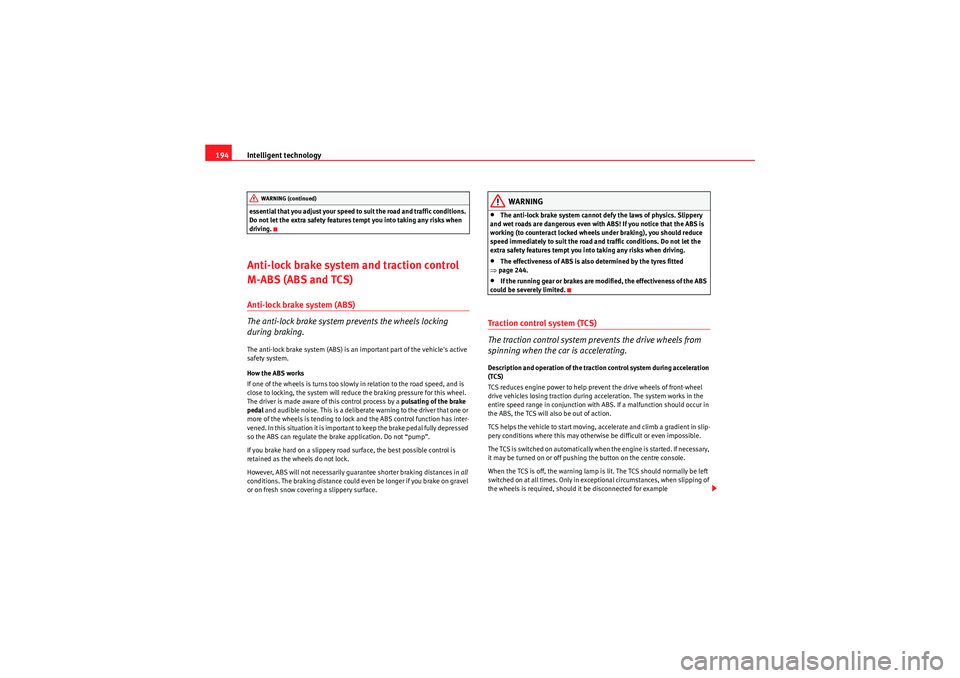
Intelligent technology
194essential that you adjust your speed to suit the road and traffic conditions.
Do not let the extra safety features tempt you into taking any risks when
driving.Anti-lock brake system and traction control
M-ABS (ABS and TCS)Anti-lock brake system (ABS)
The anti-lock brake system prevents the wheels locking
during braking.The anti-lock brake system (ABS) is an important part of the vehicle's active
safety system.
How the ABS works
If one of the wheels is turns too slowly in relation to the road speed, and is
close to locking, the system will reduce the braking pressure for this wheel.
The driver is made aware of this control process by a pulsating of the brake
pedal and audible noise. This is a deliberate warning to the driver that one or
more of the wheels is tending to lock and the ABS control function has inter-
vened. In this situation it is important to keep the brake pedal fully depressed
so the ABS can regulate the brake application. Do not “pump”.
If you brake hard on a slippery road surface, the best possible control is
retained as the wheels do not lock.
However, ABS will not necessarily gu arantee shorter braking distances in all
conditions. The braking distance could even be longer if you brake on gravel
or on fresh snow covering a slippery surface.
WARNING
•The anti-lock brake system cannot defy the laws of physics. Slippery
and wet roads are dangerous even with ABS! If you notice that the ABS is
working (to counteract locked wheels under braking), you should reduce
speed immediately to suit the road and traffic conditions. Do not let the
extra safety features tempt you into taking any risks when driving.•The effectiveness of ABS is also determined by the tyres fitted
⇒ page 244.•If the running gear or brakes are modified, the effectiveness of the ABS
could be severely limited.
Traction control system (TCS)
The traction control system prevents the drive wheels from
spinning when the car is accelerating.Description and operation of the traction control system during acceleration
(TCS)
TCS reduces engine power to help prevent the drive wheels of front-wheel
drive vehicles losing traction during acceleration. The system works in the
entire speed range in conjunction with ABS. If a malfunction should occur in
the ABS, the TCS will also be out of action.
TCS helps the vehicle to start moving, accelerate and climb a gradient in slip-
pery conditions where this may otherwise be difficult or even impossible.
T h e T C S i s s wi tch e d o n a u t o m a t i ca ll y w h e n t h e e n g i n e i s s t a r te d . I f n e ce s sa r y,
it may be turned on or off pushing the button on the centre console.
When the TCS is off, the warning lamp is lit. The TCS should normally be left
switched on at all times. Only in exceptional circumstances, when slipping of
the wheels is required, should it be disconnected for example
WARNING (continued)
AlteaXL_EN.book Seite 194 Dienstag, 1. September 2009 10:37 10
Page 197 of 312
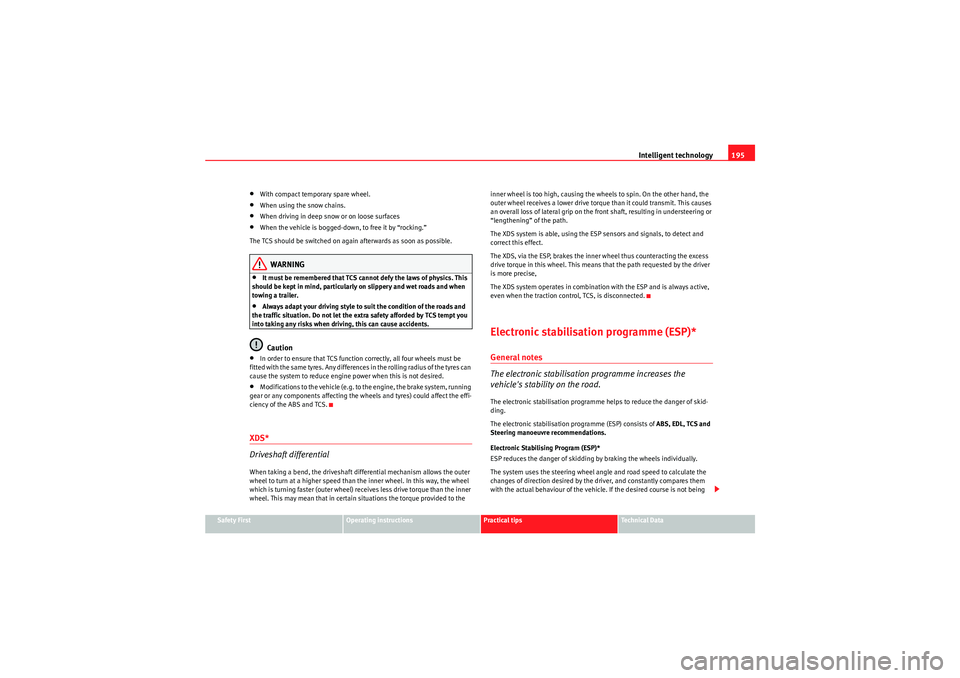
Intelligent technology195
Safety First
Operating instructions
Practical tips
Technical Data
•With compact temporary spare wheel.•When using the snow chains.•When driving in deep snow or on loose surfaces•When the vehicle is bogged-down, to free it by “rocking.”
The TCS should be switched on again afterwards as soon as possible.WARNING
•It must be remembered that TCS cannot defy the laws of physics. This
should be kept in mind, particularly on slippery and wet roads and when
towing a trailer.•Always adapt your driving style to suit the condition of the roads and
the traffic situation. Do not let the extra safety afforded by TCS tempt you
into taking any risks when driving, this can cause accidents.Caution
•In order to ensure that TCS function correctly, all four wheels must be
fitted with the same tyres. Any differences in the rolling radius of the tyres can
cause the system to reduce engine power when this is not desired.•Modifications to the vehicle (e.g. to the engine, the brake system, running
gear or any components affecting the wheels and tyres) could affect the effi-
ciency of the ABS and TCS.XDS*
Driveshaft differentialWhen taking a bend, the driveshaft differential mechanism allows the outer
wheel to turn at a higher speed than the inner wheel. In this way, the wheel
which is turning faster (outer wheel) receives less drive torque than the inner
wheel. This may mean that in certain situations the torque provided to the inner wheel is too high, causing the wheels to spin. On the other hand, the
outer wheel receives a lower drive torque than it could transmit. This causes
an overall loss of lateral grip on the front shaft, resulting in understeering or
“lengthening” of the path.
The XDS system is able, using the ESP sensors and signals, to detect and
correct this effect.
The XDS, via the ESP, brakes the inner wheel thus counteracting the excess
drive torque in this wheel. This means that the path requested by the driver
is more precise,
The XDS system operates in combination with the ESP and is always active,
even when the traction control, TCS, is disconnected.
Electronic stabilisation programme (ESP)*General notes
The electronic stabilisation programme increases the
vehicle's stability on the road.The electronic stabilisation programme helps to reduce the danger of skid-
ding.
The electronic stabilisation programme (ESP) consists of
ABS, EDL, TCS and
Steering manoeuvre recommendations.
Electronic Stabilising Program (ESP)*
ESP reduces the danger of skidding by braking the wheels individually.
The system uses the steering wheel angle and road speed to calculate the
changes of direction desired by the driver, and constantly compares them
with the actual behaviour of the vehicle. If the desired course is not being
AlteaXL_EN.book Seite 195 Dienstag, 1. September 2009 10:37 10
Page 198 of 312
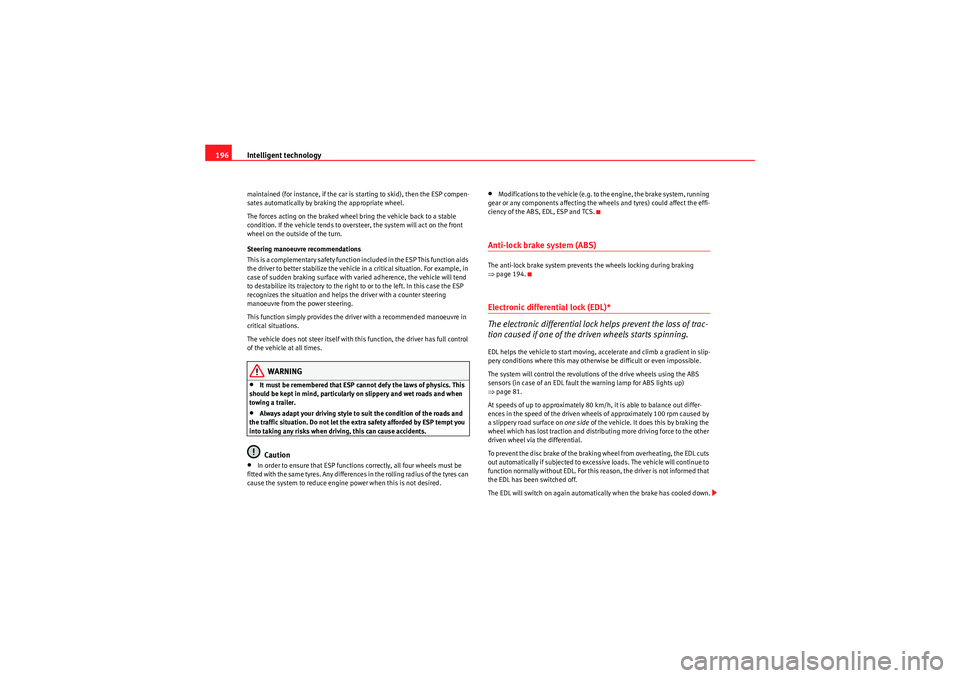
Intelligent technology
196maintained (for instance, if the car is starting to skid), then the ESP compen-
sates automatically by braking the appropriate wheel.
The forces acting on the braked wheel bring the vehicle back to a stable
condition. If the vehicle tends to oversteer, the system will act on the front
wheel on the outside of the turn.
Steering manoeuvre recommendations
This is a complementary safety function included in the ESP This function aids
the driver to better stabilize the vehicle in a critical situation. For example, in
case of sudden braking surface with varied adherence, the vehicle will tend
to destabilize its trajectory to the right to or to the left. In this case the ESP
recognizes the situation and helps the driver with a counter steering
manoeuvre from the power steering.
This function simply provides the driver with a recommended manoeuvre in
critical situations.
The vehicle does not steer itself with this function, the driver has full control
of the vehicle at all times.
WARNING
•It must be remembered that ESP cannot defy the laws of physics. This
should be kept in mind, particularly on slippery and wet roads and when
towing a trailer.•Always adapt your driving style to suit the condition of the roads and
the traffic situation. Do not let the extra safety afforded by ESP tempt you
into taking any risks when driving, this can cause accidents.Caution
•In order to ensure that ESP functions correctly, all four wheels must be
fitted with the same tyres. Any differences in the rolling radius of the tyres can
cause the system to reduce engine power when this is not desired.
•Modifications to the vehicle (e.g. to the engine, the brake system, running
gear or any components affecting the wheels and tyres) could affect the effi-
ciency of the ABS, EDL, ESP and TCS.Anti-lock brake system (ABS)The anti-lock brake system prevents the wheels locking during braking
⇒ page 194.Electronic differential lock (EDL)*
The electronic differential lock helps prevent the loss of trac-
tion caused if one of the driven wheels starts spinning.EDL helps the vehicle to start moving, accelerate and climb a gradient in slip-
pery conditions where this may otherwise be difficult or even impossible.
The system will control the revolutions of the drive wheels using the ABS
sensors (in case of an EDL fault the warning lamp for ABS lights up)
⇒ page 81.
At speeds of up to approximately 80 km/h, it is able to balance out differ-
ences in the speed of the driven wheels of approximately 100 rpm caused by
a slippery road surface on one side of the vehicle. It does this by braking the
wheel which has lost traction and distributing more driving force to the other
driven wheel via the differential.
To prevent the disc brake of the braking wheel from overheating, the EDL cuts
out automatically if subjected to excessive loads. The vehicle will continue to
function normally without EDL. For this reason, the driver is not informed that
the EDL has been switched off.
The EDL will switch on again automatically when the brake has cooled down.
AlteaXL_EN.book Seite 196 Dienstag, 1. September 2009 10:37 10
Page 199 of 312
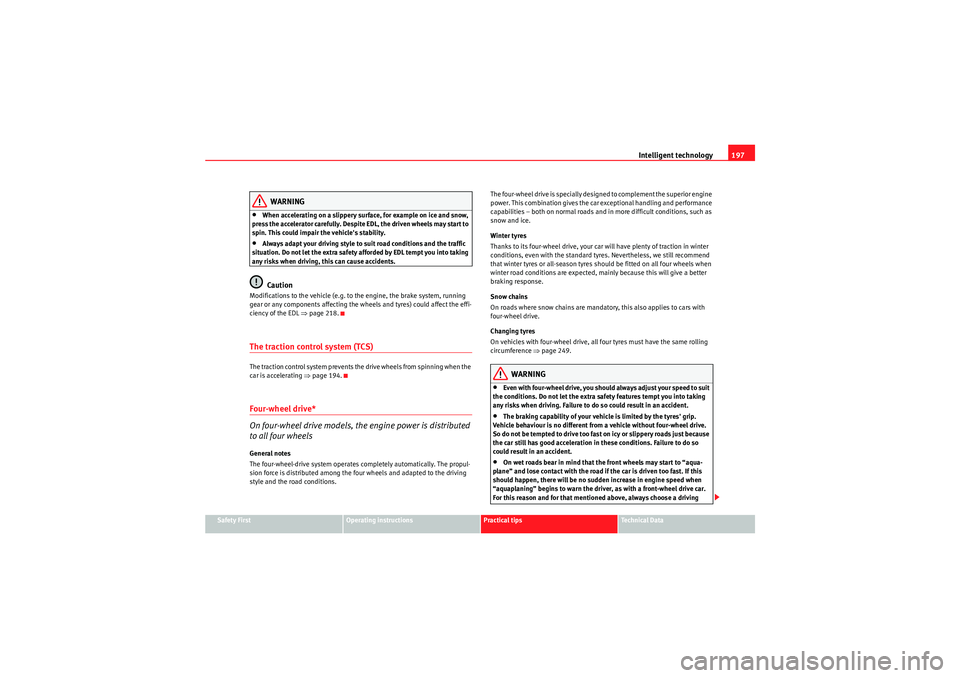
Intelligent technology197
Safety First
Operating instructions
Practical tips
Technical Data
WARNING
•When accelerating on a slippery surface, for example on ice and snow,
press the accelerator carefully. Despite EDL, the driven wheels may start to
spin. This could impair the vehicle's stability.•Always adapt your driving style to suit road conditions and the traffic
situation. Do not let the extra safety afforded by EDL tempt you into taking
any risks when driving, this can cause accidents.Caution
Modifications to the vehicle (e.g. to the engine, the brake system, running
gear or any components affecting the wheels and tyres) could affect the effi-
ciency of the EDL ⇒page 218.The traction control system (TCS)The traction control system prevents the drive wheels from spinning when the
car is accelerating ⇒page 194.Four-wheel drive*
On four-wheel drive models, the engine power is distributed
to all four wheelsGeneral notes
The four-wheel-drive system operates completely automatically. The propul-
sion force is distributed among the four wheels and adapted to the driving
style and the road conditions. The four-wheel drive is specially designed to complement the superior engine
power. This combination gives the car exceptional handling and performance
capabilities – both on normal roads and in more difficult conditions, such as
snow and ice.
Winter tyres
Thanks to its four-wheel drive, your car will have plenty of traction in winter
conditions, even with the standard tyres. Nevertheless, we still recommend
that winter tyres or all-season tyres should be fitted on all four wheels when
winter road conditions are expected, mainly because this will give a better
braking response.
Snow chains
On roads where snow chains are mandatory, this also applies to cars with
four-wheel drive.
Changing tyres
On vehicles with four-wheel drive, all four tyres must have the same rolling
circumference
⇒page 249.
WARNING
•Even with four-wheel drive, you should always adjust your speed to suit
the conditions. Do not let the extra safety features tempt you into taking
any risks when driving. Failure to do so could result in an accident.•The braking capability of your vehicle is limited by the tyres' grip.
Vehicle behaviour is no different from a vehicle without four-wheel drive.
So do not be tempted to drive too fast on icy or slippery roads just because
the car still has good acceleration in these conditions. Failure to do so
could result in an accident.•On wet roads bear in mind that the front wheels may start to “aqua-
plane” and lose contact with the road if the car is driven too fast. If this
should happen, there will be no sudden increase in engine speed when
“aquaplaning” begins to warn the driver, as with a front-wheel drive car.
For this reason and for that mentioned above, always choose a driving
AlteaXL_EN.book Seite 197 Dienstag, 1. September 2009 10:37 10
Page 305 of 312
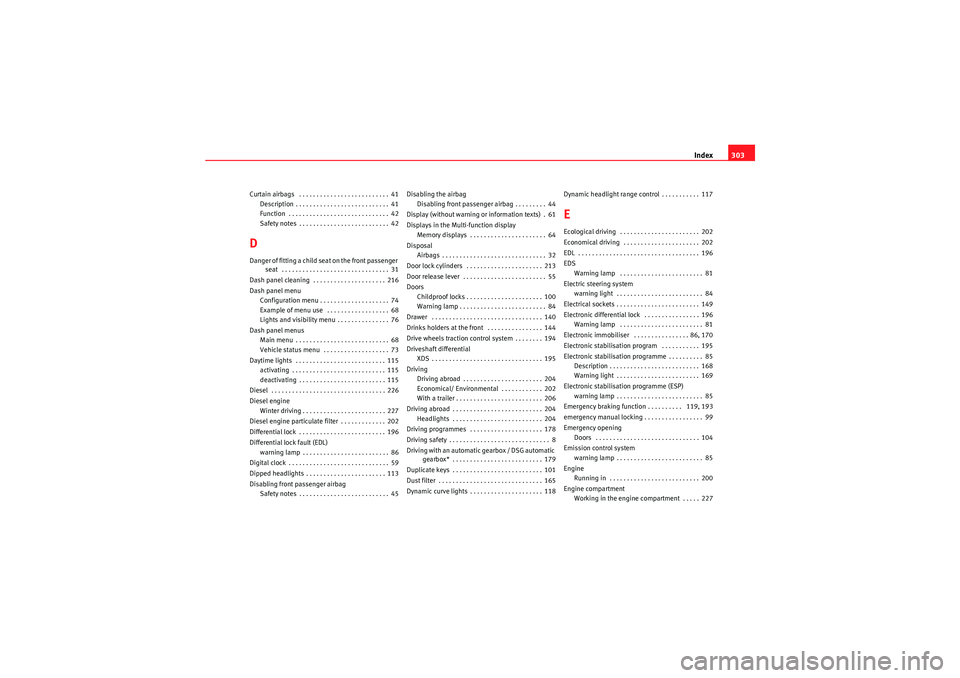
Index303
Curtain airbags . . . . . . . . . . . . . . . . . . . . . . . . . . 41
Description . . . . . . . . . . . . . . . . . . . . . . . . . . . 41
Function . . . . . . . . . . . . . . . . . . . . . . . . . . . . . 42
Safety notes . . . . . . . . . . . . . . . . . . . . . . . . . . 42DDanger of fitting a child seat on the front passenger seat . . . . . . . . . . . . . . . . . . . . . . . . . . . . . . . 31
Dash panel cleaning . . . . . . . . . . . . . . . . . . . . . 216
Dash panel menu Configuration menu . . . . . . . . . . . . . . . . . . . . 74
Example of menu use . . . . . . . . . . . . . . . . . . 68
Lights and visibility menu . . . . . . . . . . . . . . . 76
Dash panel menus Main menu . . . . . . . . . . . . . . . . . . . . . . . . . . . 68
Vehicle status menu . . . . . . . . . . . . . . . . . . . 73
Daytime lights . . . . . . . . . . . . . . . . . . . . . . . . . . 115 activating . . . . . . . . . . . . . . . . . . . . . . . . . . . 115
deactivating . . . . . . . . . . . . . . . . . . . . . . . . . 115
Diesel . . . . . . . . . . . . . . . . . . . . . . . . . . . . . . . . . 226
Diesel engine Winter driving . . . . . . . . . . . . . . . . . . . . . . . . 227
Diesel engine particulate filter . . . . . . . . . . . . . 202
Differential lock . . . . . . . . . . . . . . . . . . . . . . . . . 196
Differential lock fault (EDL) warning lamp . . . . . . . . . . . . . . . . . . . . . . . . . 86
Digital clock . . . . . . . . . . . . . . . . . . . . . . . . . . . . . 59
Dipped headlights . . . . . . . . . . . . . . . . . . . . . . . 113
Disabling front passenger airbag Safety notes . . . . . . . . . . . . . . . . . . . . . . . . . . 45 Disabling the airbag
Disabling front passenger airbag . . . . . . . . . 44
Display (without warning or information texts) . 61
Displays in the Multi-function display Memory displays . . . . . . . . . . . . . . . . . . . . . . 64
Disposal Airbags . . . . . . . . . . . . . . . . . . . . . . . . . . . . . . 32
Door lock cylinders . . . . . . . . . . . . . . . . . . . . . . 213
Door release lever . . . . . . . . . . . . . . . . . . . . . . . . 55
Doors Childproof locks . . . . . . . . . . . . . . . . . . . . . . 100
Warning lamp . . . . . . . . . . . . . . . . . . . . . . . . . 84
Drawer . . . . . . . . . . . . . . . . . . . . . . . . . . . . . . . . 140
Drinks holders at the front . . . . . . . . . . . . . . . . 144
Drive wheels traction control system . . . . . . . . 194
Driveshaft differential XDS . . . . . . . . . . . . . . . . . . . . . . . . . . . . . . . . 195
Driving Driving abroad . . . . . . . . . . . . . . . . . . . . . . . 204
Economical/ Environmental . . . . . . . . . . . . 202
With a trailer . . . . . . . . . . . . . . . . . . . . . . . . . 206
Driving abroad . . . . . . . . . . . . . . . . . . . . . . . . . . 204 Headlights . . . . . . . . . . . . . . . . . . . . . . . . . . 204
Driving programmes . . . . . . . . . . . . . . . . . . . . . 178
Driving safety . . . . . . . . . . . . . . . . . . . . . . . . . . . . . 8
Driving with an automatic gearbox / DSG automatic gearbox* . . . . . . . . . . . . . . . . . . . . . . . . . . 179
Duplicate keys . . . . . . . . . . . . . . . . . . . . . . . . . . 101
Dust filter . . . . . . . . . . . . . . . . . . . . . . . . . . . . . . 165
Dynamic curve lights . . . . . . . . . . . . . . . . . . . . . 118 Dynamic headlight range control . . . . . . . . . . . 117
EEcological driving . . . . . . . . . . . . . . . . . . . . . . . 202
Economical driving . . . . . . . . . . . . . . . . . . . . . . 202
EDL . . . . . . . . . . . . . . . . . . . . . . . . . . . . . . . . . . . 196
EDS
Warning lamp . . . . . . . . . . . . . . . . . . . . . . . . 81
Electric steering system warning light . . . . . . . . . . . . . . . . . . . . . . . . . 84
Electrical sockets . . . . . . . . . . . . . . . . . . . . . . . . 149
Electronic differential lock . . . . . . . . . . . . . . . . 196 Warning lamp . . . . . . . . . . . . . . . . . . . . . . . . 81
Electronic immobiliser . . . . . . . . . . . . . . . . 86, 170
Electronic stabilisation program . . . . . . . . . . . 195
Electronic stabilisation programme . . . . . . . . . . 85 Description . . . . . . . . . . . . . . . . . . . . . . . . . . 168
Warning light . . . . . . . . . . . . . . . . . . . . . . . . 169
Electronic stabilisation programme (ESP) warning lamp . . . . . . . . . . . . . . . . . . . . . . . . . 85
Emergency braking function . . . . . . . . . . 119, 193
emergency manual locking . . . . . . . . . . . . . . . . . 99
Emergency opening Doors . . . . . . . . . . . . . . . . . . . . . . . . . . . . . . 104
Emission control system warning lamp . . . . . . . . . . . . . . . . . . . . . . . . . 85
Engine Running in . . . . . . . . . . . . . . . . . . . . . . . . . . 200
Engine compartment Working in the engine compartment . . . . . 227
AlteaXL_EN.book Seite 303 Dienstag, 1. September 2009 10:37 10
Page 310 of 312
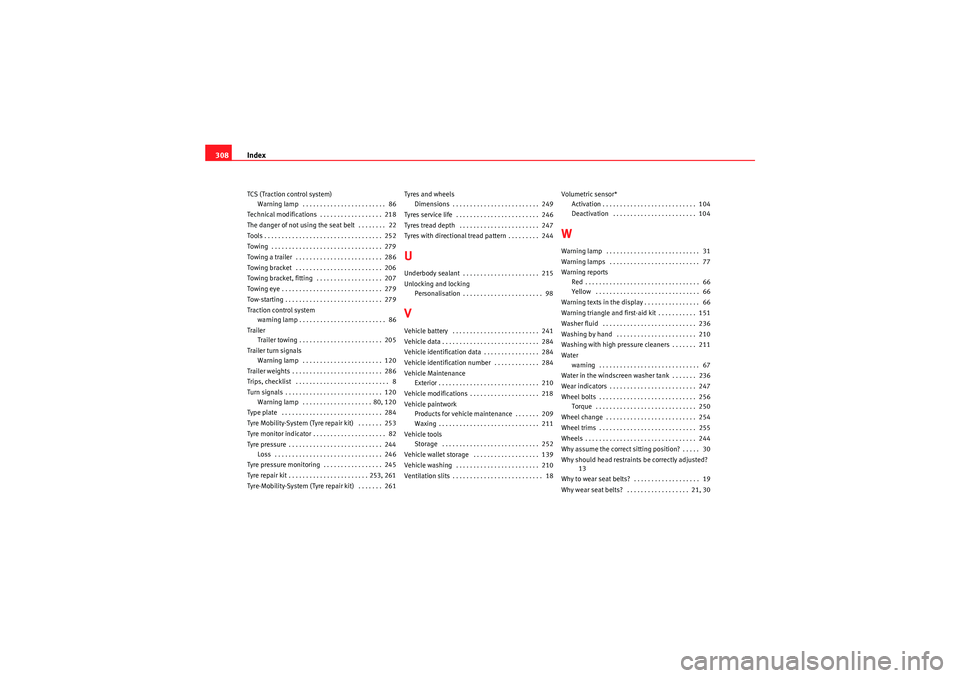
Index
308TCS (Traction control system)
Warning lamp . . . . . . . . . . . . . . . . . . . . . . . . 86
Technical modifications . . . . . . . . . . . . . . . . . . 218
The danger of not using the seat belt . . . . . . . . 22
Tools . . . . . . . . . . . . . . . . . . . . . . . . . . . . . . . . . . 252
Towing . . . . . . . . . . . . . . . . . . . . . . . . . . . . . . . . 279
Towing a trailer . . . . . . . . . . . . . . . . . . . . . . . . . 286
Towing bracket . . . . . . . . . . . . . . . . . . . . . . . . . 206
Towing bracket, fitting . . . . . . . . . . . . . . . . . . . 207
Towing eye . . . . . . . . . . . . . . . . . . . . . . . . . . . . . 279
Tow-starting . . . . . . . . . . . . . . . . . . . . . . . . . . . . 279
Traction control system warning lamp . . . . . . . . . . . . . . . . . . . . . . . . . 86
Trailer Trailer towing . . . . . . . . . . . . . . . . . . . . . . . . 205
Trailer turn signals Warning lamp . . . . . . . . . . . . . . . . . . . . . . . 120
Trailer weights . . . . . . . . . . . . . . . . . . . . . . . . . . 286
Trips, checklist . . . . . . . . . . . . . . . . . . . . . . . . . . . 8
Turn signals . . . . . . . . . . . . . . . . . . . . . . . . . . . . 120 Warning lamp . . . . . . . . . . . . . . . . . . . . 80, 120
Type plate . . . . . . . . . . . . . . . . . . . . . . . . . . . . . 284
Tyre Mobility-System (Tyre repair kit) . . . . . . . 253
Tyre monitor indicator . . . . . . . . . . . . . . . . . . . . . 82
Tyre pressure . . . . . . . . . . . . . . . . . . . . . . . . . . . 244 Loss . . . . . . . . . . . . . . . . . . . . . . . . . . . . . . . 246
Tyre pressure monitoring . . . . . . . . . . . . . . . . . 245
Tyre repair kit . . . . . . . . . . . . . . . . . . . . . . . 253, 261
Tyre-Mobility-System (Tyre repair kit) . . . . . . . 261 Tyres and wheels
Dimensions . . . . . . . . . . . . . . . . . . . . . . . . . 249
Tyres service life . . . . . . . . . . . . . . . . . . . . . . . . 246
Tyres tread depth . . . . . . . . . . . . . . . . . . . . . . . 247
Tyres with directional tread pattern . . . . . . . . . 244
UUnderbody sealant . . . . . . . . . . . . . . . . . . . . . . 215
Unlocking and locking Personalisation . . . . . . . . . . . . . . . . . . . . . . . 98VVehicle battery . . . . . . . . . . . . . . . . . . . . . . . . . 241
Vehicle data . . . . . . . . . . . . . . . . . . . . . . . . . . . . 284
Vehicle identification data . . . . . . . . . . . . . . . . 284
Vehicle identification number . . . . . . . . . . . . . 284
Vehicle MaintenanceExterior . . . . . . . . . . . . . . . . . . . . . . . . . . . . . 210
Vehicle modifications . . . . . . . . . . . . . . . . . . . . 218
Vehicle paintwork Products for vehicle maintenance . . . . . . . 209
Waxing . . . . . . . . . . . . . . . . . . . . . . . . . . . . . 211
Vehicle tools Storage . . . . . . . . . . . . . . . . . . . . . . . . . . . . 252
Vehicle wallet storage . . . . . . . . . . . . . . . . . . . 139
Vehicle washing . . . . . . . . . . . . . . . . . . . . . . . . 210
Ventilation slits . . . . . . . . . . . . . . . . . . . . . . . . . . 18 Volumetric sensor*
Activation . . . . . . . . . . . . . . . . . . . . . . . . . . . 104
Deactivation . . . . . . . . . . . . . . . . . . . . . . . . 104
WWarning lamp . . . . . . . . . . . . . . . . . . . . . . . . . . . 31
Warning lamps . . . . . . . . . . . . . . . . . . . . . . . . . . 77
Warning reportsRed . . . . . . . . . . . . . . . . . . . . . . . . . . . . . . . . . 66
Yellow . . . . . . . . . . . . . . . . . . . . . . . . . . . . . . 66
Warning texts in the display . . . . . . . . . . . . . . . . 66
Warning triangle and first-aid kit . . . . . . . . . . . 151
Washer fluid . . . . . . . . . . . . . . . . . . . . . . . . . . . 236
Washing by hand . . . . . . . . . . . . . . . . . . . . . . . 210
Washing with high pressure cleaners . . . . . . . 211
Water warning . . . . . . . . . . . . . . . . . . . . . . . . . . . . . 67
Water in the windscreen washer tank . . . . . . . 236
Wear indicators . . . . . . . . . . . . . . . . . . . . . . . . . 247
Wheel bolts . . . . . . . . . . . . . . . . . . . . . . . . . . . . 256 Torque . . . . . . . . . . . . . . . . . . . . . . . . . . . . . 250
Wheel change . . . . . . . . . . . . . . . . . . . . . . . . . . 254
Wheel trims . . . . . . . . . . . . . . . . . . . . . . . . . . . . 255
Wheels . . . . . . . . . . . . . . . . . . . . . . . . . . . . . . . . 244
Why assume the correct sitting position? . . . . . 30
Why should head restraints be correctly adjusted? 13
Why to wear seat belts? . . . . . . . . . . . . . . . . . . . 19
Why wear seat belts? . . . . . . . . . . . . . . . . . . 21, 30
AlteaXL_EN.book Seite 308 Dienstag, 1. September 2009 10:37 10